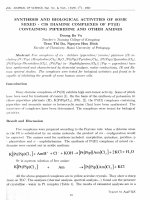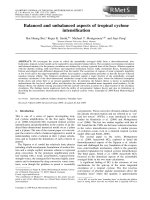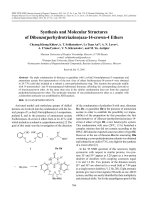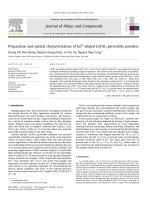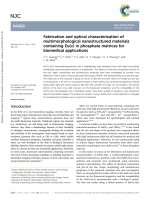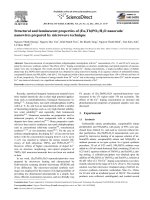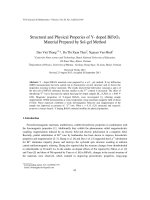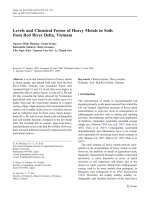DSpace at VNU: Distribution and Population Densities of Diurnal Primates in the Karst Forests of Phong Nha-Ke Bang National Park, Quang Binh Province, Central Vietnam
Bạn đang xem bản rút gọn của tài liệu. Xem và tải ngay bản đầy đủ của tài liệu tại đây (283.03 KB, 12 trang )
Int J Primatol (2009) 30:301–312
DOI 10.1007/s10764-009-9343-4
Distribution and Population Densities of Diurnal
Primates in the Karst Forests of Phong Nha – Ke
Bang National Park, Quang Binh Province,
Central Vietnam
Tanja Haus & Martina Vogt & Bernhard Forster &
Ngoc Thanh Vu & Thomas Ziegler
Received: 6 August 2008 / Accepted: 18 December 2008 /
Published online: 8 February 2009
# Springer Science + Business Media, LLC 2009
Abstract We studied the status and distribution of the diurnal primates in the Phong
Nha – Ke Bang National Park (PNKB NP) from April to August 2007. In the past,
researchers reported 9 primate species and subspecies for the karst forests of PNKB
NP, which constitutes the most important protected area for the endangered Hatinh
langur (Trachypithecus hatinhensis) in Vietnam. All 9 primate taxa are threatened
due to hunting pressure and habitat loss. We applied line transect sampling in 4
areas. During a total of 117 transect inspections along 12 different transect routes,
we confirmed 5 primate taxa and the analysis of population densities resulted in
2143 (±467) Hatinh langurs, 1316 (±871) red-shanked douc langurs (Pygathrix
nemaeus), 930 (±489) stump-tailed macaques (Macaca arctoides), 986 (±883)
eastern Assamese macaques (M. a. assamensis), and 18 (±18) southern whitecheeked crested gibbons (Nomascus siki) in the whole PNKB NP, which covers an
area of ca. 85,000 ha. We could not detect the 2 nocturnal lorises, Bengal slow
lorises (Nycticebus bengalensis) and pygmy slow lorises (N. pygmaeus), as well as
T. Haus
Zoologisches Forschungsmuseum Alexander Koenig, 53113 Bonn, Germany
T. Haus
AG Zoologischer Garten Köln, 50735 Köln, Germany
M. Vogt : B. Forster
Phong Nha – Ke Bang National Park, Son Trach Commune, Bo Trach District, Quang Binh Province,
Vietnam
N. T. Vu
University of Science, Faculty of Biology, Department of Vertebrate Zoology, Zoological Museum,
Vietnam National University, Thanh Xuan, Hanoi, Vietnam
T. Ziegler (*)
AG Zoologischer Garten Köln, 50735 Köln, Germany
e-mail:
302
T. Haus et al.
rhesus macaques (Macaca mulatta) and northern pig-tail macaques (M. leonina).
The distribution of the primates predominantly depended on human impact. We
could not recognize a correlation between habitat constitution and abundance of
primates. The population density estimates showed a much higher density of the
Hatinh langur than previously assumed. Thus the importance of the PNKB NP for
the conservation of this endangered langur increased significantly.
Keywords Hatinh langur (Trachypithecus hatinhensis) .
Phong Nha – Ke Bang National Park . Vietnam . population densities . primate census
Introduction
Phong Nha – Ke Bang National Park (PNKB NP) is located in the Central Annamite
Mountains (170°20′–170°48′N and 1050°46′–1060°24′E) in Quang Binh Province,
Vietnam and was declared a UNESCO World Heritage Site in 2003 (Vogt et al.
2006; Ziegler et al. 2004). Pham Nhat and Nguyen Xuan Dang (2000) documented 9
of the 24 primate taxa known to occur in Vietnam (Nadler and Streicher 2004) for
the karst forests of PNKB NP. The taxa represent 5 genera and 3 families of both
Strepsirrhini and Haplorrhini: Hatinh langurs (Trachypithecus hatinhensis), redshanked douc langurs (Pygathrix nemaeus), stump-tailed macaques (Macaca
arctoides), eastern Assamese macaques (M. a. assamensis; subsequently simply
referred to as Assamese macaque, M. assamensis), rhesus macaques (M. mulatta),
northern pig-tail macaques (M. leonina), southern white-cheeked crested gibbons
(Nomascus siki), and the 2 nocturnal lorises Bengal slow lorises (Nycticebus
bengalensis) and pygmy slow lorises (N. pygmaeus). Here we follow the taxonomy
of Groves (2005).
All 9 taxa are listed in the IUCN Red List of Threatened Species and in the Red
Data Book of Vietnam (Nguyen Vu Khoi and Shaw 2004; IUCN 2007). They are
threatened due to habitat loss and hunting pressure (Nadler et al. 2003; Timmins
et al. 1999; Vogt and Forster 2008; Vu Ngoc Thanh et al. 2004). Hatinh langurs and
red-shanked douc langurs are endemic to the karst forests of the Truong Son
(Annamite Mountains) in Central Vietnam and Laos. The distribution of Hatinh
langurs is restricted to Vietnam’s Quang Binh and Quang Tri provinces (BirdLife
International Vietnam Programme 2005; Nadler et al. 2003). Besides the recently
declared Bac Huong Hoa Nature Reserve in Quang Tri, the PNKB NP is the only
protected area within the distribution range of Hatinh langurs in Vietnam (Nguyen
Manh Ha 2006; Timmins et al. 1999).
There have been several recent surveys to determine the biodiversity of the PNKB
NP including studies focused on primates (Dinh Hai Duong 2005; Le Khac Quyet
et al. 2002; Le Xuan Canh et al. 1997; Nguyen Quang Vinh 2002; Timmins et al.
1999). Results of these investigations showed that the density of most primate
species and subspecies seems to be relatively low. However, these data did not
provide estimates of the population densities. To protect endangered species and to
observe important changes of population structure and size in time, data collected by
standardized census methods are necessary. To date there have been approximations
of only 520–750 Hatinh langurs occurring in that area (Le Xuan Canh et al. 1997;
Diurnal Primates in Phong Nha – Ke Bang National Park
303
Pham Nhat et al. 1996). Thus it was essential to investigate for the first time the
population densities of the primates in the PNKB NP.
Methods
Study Site
PNKB NP is in the western part of Central Vietnam 500 km south of Hanoi and
borders on Laos (Fig. 1). It includes ca. 85,000 ha of karst forests, providing habitat
for many endemic species of both flora and fauna (Herrmann and Pagel 2000;
Timmins et al. 1999; Ziegler et al. 2006, 2007). The area is characterized by steep
limestone hills, which are covered by dense forests. The evergreen primary forest,
which has remained almost unaffected, accounts for ca. 88% of the area (Cao Xuan
Chinh 2005). Large portions of the National Park are 500–1000 m above sea level
(Herrmann and Pagel 2000).
Census Method and Data Collection
We conducted line transect sampling in 4 different areas in the PNKB NP from April
to August in 2007: Cha Noi in the north, Hung Lau and Hang E in the east, and Ban
Doong in the southeast of the National Park (Fig. 1). We did not include the
difficult-to-access southwest part of the National Park because of time limits. Except
for Hang E, the survey areas are composed predominately of unaffected primary
forests. The Hang E area is situated near villages in the border zone and is delimited
by 2 roads that cross the National Park (Fig. 1). The survey area is characterized by a
flat lowland valley surrounded by steep limestone cliffs and hills. The valley is
Fig. 1 Location of the 4 survey areas in the Phong Nha – Ke Bang National Park in Central Vietnam.
304
T. Haus et al.
covered by dense secondary forest, whereas the surrounding higher elevations are
covered by primary forest.
In each of the 4 survey areas we defined 3 different line transects (Hung Lau:
HL1–3, Hang E: HE4–6, Cha Noi: CN7–9, Ban Doong: BD10–12), which ran
nearly parallel at ca. 500 m from each other or from the base-camp in different
directions (Peres 1999). In Hang E, we could not maintain the minimum distance
throughout the transect lines because of terrain topography. According to Ross and
Reeve (2003) it is less important if objects are detected twice in 2 different transect
walks of the same transect or in 2 walks of different transects, provided that
detections are independently; then they should be treated as separate independent
encounters for analyses. Because of dense vegetation and the prevalence of steep and
cliffy terrain, we predominantly used preexisting trails as transects. We marked parts
of transects, and transects not following trails, by snapping off branches. In addition,
we tracked all transects via a GPS (Garmin GPS 60) with an external antenna
(Gilsson Technologies, High Gain GPS Antenna, MCX).
Because of the assumed low density of primates, ideally we should have surveyed
each transect 10 times during 2 study periods from April to June and July to August
2007, but we surveyed the transects BD10 and BD11 only 9 and 8 times
respectively, due to weather conditions. The length of transects varied between
1.74 km and 5.03 km; depending on terrain and distance we were able to walk in a
4-h interval. We walked very slowly and as quietly as possible, stopping often to
avoid obstacles and uneven ground to meet the assumptions that all primates are
detected directly on and above the transect line and do not move before in response
to the observers (Buckland et al. 2001; Ross and Reeve 2003). We walked each
transect twice a day, between 0600 h and 1000 h and 1400 h and 1800 h during the
greatest periods of diurnal primate activity (Peres 1999). The duration of a single
transect walk varied depending on time allocated to detection events and data
collection. We kept a midday period of ca. 3 h to avoid influencing observations on
the afternoon walk. In the event of rainfall we would pause the survey until the rain
stopped, due to bad visibility and the distracting noise caused by the rain. Two
observers recorded the data, and both surveyed each transect route 4–6 times. A
team consisting of ≤3 people accompanied the observers, a National Park staff
member, rangers, and local guides. We recorded date, start and ending time, transect
identity, weather conditions, personnel, and human activities of each transect walk
and species identity, group size, group structure, cue, activity, substrate, sighting
height in the tree, vegetation features, and GPS coordinates (Garmin GPS 60 with
external Antenna and Garmin GPS 12) at every detection event. To analyze the
population density we measured the perpendicular distance or the radial distance and
the angle relative to the transect line to each first sighted individual via a range
finder (Bushnell, Yardage Pro Legend) and an angle board (Buckland et al. 2001).
Transect Measuring and Vegetation Description
To compare the primate densities between the different transects and survey areas,
we measured the surface area of each transect; for this purpose, we measured the
perpendicular visibility range to both sides of the transect line at every 20 m on
average by a range finder. Thereby several sections originated, the surface area of
Diurnal Primates in Phong Nha – Ke Bang National Park
305
which we calculated from the length and the mean of the lateral visibility ranges at
the beginning and the end of the section. The sum of all surface areas resulted in the
total area of each transect.
The basic vegetation structure was described by 4 parameters determined for each
section of transect. We measured the height of canopy via a range finder and
determined canopy cover by measuring the percentage of open sky. We estimated the
density of understorey by percentage of ground covered with vegetation and the
growth of liana on a scale from 1 to 3 (1: few, 2: medium, 3: plenty).
Data Analyses
The applied distance sampling method assumes that only a proportion of primates
will be seen and that the detection probability decreases with increasing distance
from the line. We used DISTANCE (Version 5.0, Thomas et al. 2006) to fit a set of
detection probability models to the observed perpendicular distances, and selected the
best model showing the smallest value of Akaike’s Information Criterion. In this manner,
DISTANCE estimates the proportion of primates missed by the survey and computes the
population density in the survey area (Thomas et al. 2002). In multispecies surveys of
animals similar in size and aural cues, the data of all taxa can be pooled to estimate a
common detection function increasing sample size and statistical power (Buckland
et al. 2001). Based on poststratifying (Thomas et al. 2006), we obtained the mean
group size and population density estimates of each taxon.
We conducted Mann-Whitney U and regression tests —linear correlation (r) or
Spearman rank correlation (rs)— on a level of significance with α=0.05, using PAST
(Hammer et al. 2001).
The encounters along transects were partially clustered. To analyze the relation
between vegetation structure and primate abundance, we divided each transect into 3
equal parts to obtain more small-scale vegetation descriptions and to specify
potential influence of the vegetation structure.
Results
During 2 survey phases we conducted 117 transect inspections covering an area of
2410.47 ha on a length of 358.15 km. There is no significant difference in the
number of encounters across the 2 observers (N1 =47, N2 =49, p=0.317), and the
number of sightings is independent of the number of team members (N=121,
rs =0.028, p=0.757). Further, the number of observations do not differ significantly
across the morning and afternoon transects (Nam =68, Npm =53, p=0.845).
We recorded 72 observations of 5 diurnal taxa. Sighting events and observed
group sizes of each taxon were relatively low (Table I). We detected no correlation
between group size and perpendicular distance (N=43, r=−0.239, p=0.122).
Hatinh langurs were present in each of the survey areas, and we encountered
significantly more Hatinh langurs than stump-tailed macaques (N=12, p=0.018),
Assamese macaques (N=12, p=0.038), and white-cheeked crested gibbons (N=12,
p=0.001).
306
T. Haus et al.
Table I Number of observed groups (n), mean group size (M), and range (R) in comparison with results
of previous studies
Current study
Results of previous studies
n
M
R
M
R
Source
Trachypithecus hatinhensis
27
3.54
1–10
Pygathrix nemaeus
Macaca a. assamensis
13
12
6.25
5.11
1–11
1–12
2–18
1–11
6–24
1–20
10–50
Pham Nhat et al. 1996a
Haus et al., unpubl. datab
Lippold and Vu Ngoc Thanh 2008c
Haus et al., unpubl. datab
Fooden 1971d
Macaca arctoides
Nomascus siki
9
1
5.89
1
2–11
0
7.30
5.09
14.25
7.14
–
–
–
Phong Nha – Ke Bang (PNKB) and adjacent areas.
Recorded during point transect sampling in the PNKB National Park in 2007.
c
Son Tra Nature Reserve, Da Nang, Vietnam.
d
Western Thailand.
a
b
We recognized differences in species distribution and abundance across the survey
areas and transects. The fewest primate species (2 species) occurred in Hang E and the
most (5 species) in Hung Lau (Fig. 2a). We observed most Hatinh langurs in Hang E,
where in addition only Macaca was present. Red-shanked douc langurs were the
second most frequent species, which were most common in Hung Lau (Fig. 2). We
observed Assamese macaques most often in Ban Doong, whereas we recorded all
sightings on the same transect (BD12, Fig. 2). We observed a single white-cheeked
Fig. 2 Distribution and density of recorded primate groups throughout the survey areas (a) and transects
(b) from April to August in 2007.
Diurnal Primates in Phong Nha – Ke Bang National Park
307
crested gibbon only once in Hung Lau on HL1 (Fig. 2). For all species combined, the
highest primate densities were on BD12 in Ban Doong and on HL1 in Hung Lau, and
the lowest on HL2 and HL3 in Hung Lau (Fig. 2b).
Population density estimates received from DISTANCE (Table II) showed highest
density with lowest standard deviation (SD) for Hatinh langurs. If we analyzed the
population density with a higher mean group size of 5.09 individuals, derived from
point transect sampling in the PNKB NP in 2007 (Haus et al., unpubl. data), the
population density of Hatinh langurs increased by 44% (Table II). We estimated the
lowest density with highest SD for southern white-cheeked crested gibbons.
In addition to the single encounter of the southern white-cheeked crested gibbon
in Hung Lau, we heard several song bouts early as well as late in the morning and
during midday on 8 different days. Between 0512 h and 0649 h we noticed both
solos of a single male and duet song bouts. One time we heard 2 pairs
simultaneously from different directions. During the midday breaks on HL1 we
heard duet song bouts as well as a male solo song bout; the latest song bout was
produced at 1320 h. Even though we did not record any gibbon in Ban Doong
during survey time, male and female individuals sang between 0454 h and 0530 h on
6 d. We noticed duet song bouts of 2 pairs simultaneously from different directions
as well as a solo song bout of a single male.
The analyses of the vegetation parameters of the transects show no correlation
between canopy cover (N=34, rs =0.184, p=0.298), height of canopy (N=34,
rs =−0.045, p=0.799), density of understorey (N=34, rs =−0.064, p=0.719) and
growth of liana (N=34, rs =0.12, p=0.5), and primate abundance, neither for all
species pooled, nor for any single species.
During the transect surveys we met 42 groups of people, who passed through
the PNKB NP for logging activities. Most people came from villages of the
border area. The primate abundance correlates significantly negatively with the
number of loggers encountered on transects (N=111, rs =−0.336, p=0.001;
Fig. 3), as does the number of camp sites and recorded primates (N=12, r=−0.688,
p=0.013; Fig. 4).
Table II Number of observed groups (n) and population density estimates of the primates in the Phong
Nha–Ke Bang National Park (PNKB NP) in 2007
n
Trachypithecus hatinhensis
Trachypithecus hatinhensisb
Pygathrix nemaeus
Macaca a. assamensis
Macaca arctoides
Nomascus siki
a
27
27
13
12
9
1
Population densities DISTANCE
Groups/100 ha
Individuals/100 ha
Individuals in the PNKB NPa
0.495±0.108
0.495±0.108
0.248±0.157
0.227±0.193
0.186±0.094
0.021±0.021
1.754±0.500
2.520±0.550
1.548±1.024
1.160±1.093
1.094±0.575
0.021±0.021
1491±425
2143±467
1316±871
986±883
930±489
18±18
Area of the PNKB NP: 85,000 ha.
Densities using an average group size of 5.09 (derived from point transect sampling in the PNKB NP in
2007; Haus et al., unpubl. data).
b
308
T. Haus et al.
Fig. 3 Relation of abundance of primates and loggers on transects.
Discussion
Distribution
Except for Hang E, we observed similar numbers of taxa and primate densities in all
survey areas. Hang E is in the border zone and is delimited by the 2 roads crossing
the National Park. Hunting pressure and habitat disturbance become more apparent
in such restricted areas. Roads often constitute an impassable barrier for many
species and obstruct migration of primate groups (Nadler et al. 2003). Owing to the
lack of exchange possibilities with other groups of adjacent areas, already disturbed
populations can hardly regenerate. Nevertheless we noticed a distribution peak of
Hatinh langurs in Hang E. The wide valley is surrounded by steep limestone cliffs,
which offer the species many potential sleeping sites. The single encounter of
Macaca during transect surveys in Hang E was a specimen seen near the campsite in
the morning. Most probably it was an Assamese macaque, because we recorded a
male specimen that was unmistakably referred to this species in the immediate
Fig. 4 Relation of abundance of primates and camp sites on transects.
Diurnal Primates in Phong Nha – Ke Bang National Park
309
vicinity of the campsite in the evening. Macaques seem much more likely to cross
roads than the colobines or gibbons.
White-cheeked crested gibbons occurred in only 2 of the 4 survey areas and seem
to be restricted to certain regions of the National Park. The species usually inhabits
elevations 30–100 m above sea level (Geissmann et al. 2000), but we observed it
≤600 m above sea level in Hung Lau and also in elevations 176–398 m above sea
level in Ban Doong, where we heard song bouts. The karst forests of the PNKB NP,
predominantly >100 m above sea level, are a suboptimal habitat for the taxon
(Herrmann and Pagel 2000). The restricted distribution could also be due to the
specialized diet, making the species dependent on the availability of widespread ripe
fruits (Geissmann 2003).
In previous studies, researchers documented northern pig-tail macaques and
rhesus macaques for the PNKB NP, but we did not recognize the 2 species during the
5 mo. There are different data about the distribution of northern pig-tail macaques in
Vietnam. According to Fooden (1996), the distribution stretches from 14°41′N
southward (southernmost part of PNKB NP: 17°48′N) and there exists only disputed
information about an occurrence farther to the north. Nevertheless Le Xuan Canh
et al. (1997) and Timmins et al. (1999) recorded the species in the PNKB NP in the
past. During more recent studies, northern pig-tail macaques were not recorded
(Dinh Hai Duong 2005; Le Khac Quyet et al. 2002; Nguyen Quang Vinh 2002).
Information of records of rhesus macaques also varies from study to study; Pham
Nhat et al. (1996), Le Xuan Canh et al. (1997), and Dinh Hai Duong (2005) found
rhesus macaques, whereas Timmins et al. (1999), Le Khac Quyet et al. (2002), and
Nguyen Quang Vinh (2002) failed to record the species. In Nepal, within the
distribution range of western Assamese macaques (Macaca assamensis pelops),
mulatta and pelops occur parapatrically due to the similar niche utilization (Wada
2005). Hence status and distribution of northern pig-tail and rhesus macaques in the
PNKB NP are still unclear and should be emphasized in further studies.
Because we conducted surveys only in daytime, we did not see any of the 2
nocturnal lorises. There is only minor evidence of the lorises, due to their cryptic
behaviour at day and low numbers of night surveys conducted in the PNKB NP.
Most data are based on interviews with local hunters (Le Xuan Canh et al. 1997).
Vogt and Ziegler observed 1 pygmy slow loris in the PNKB NP during a night
survey on June 14, 2005. To determine their status and distribution in the PNKB NP,
we recommend night surveys focused on lorises in the near future.
We found no correlation between vegetation parameters and primate abundance.
But at large, the vegetation structures of the transects did not differ greatly from each
other. A more detailed habitat description and phenology would be necessary to
determine primate distribution depending on habitat structure.
Population Sizes
In dense habitats, group sizes are easily underestimated because not all individuals
are detected due to bad visibility conditions and the fact that group members may be
dispersed over a large area. This can influence the estimation of population densities.
Mean group sizes in our study were relatively low compared to results of previous
surveys in the area. We often observed a single male Hatinh langur (in 10 of 27
310
T. Haus et al.
cases) sitting and scanning in the top of a tree. The possibility remains that other
group members were undetected in the dense vegetation beneath, but because they
were not observed this is simply a hypothetical supposition. Therefore the
population density estimate of the Hatinh langur based on our reliable mean group
size of 5.09 results in a population estimate of 2143 (± 467) individuals for PNKB
NP. This is a more reasonable estimate than that offered by Pham Nhat et al. (1996),
who suggested that ca. 520–670 individuals were in the PNKB area or Le Xuan
Canh et al. (1997), who estimated ≤750 individuals. Thus the density of Hatinh
langurs is much higher than previously assumed.
Timmins et al. (1999) recorded only 1 group of red-shanked douc langurs during
a 4-mo study. Based on results of previous studies, they assumed the population of
the species had undergone a more significant decline than most other primate
species. Consistent with our results, red-shanked douc langurs were more often
observed in recent surveys (Dinh Hai Duong 2005; Nguyen Quang Vinh 2002), and
appear to be the second most frequent primate species in the PNKB NP today. In
contrast to those of Timmins et al. (1999), our results show that Assamese and
stump-tailed macaques are less common than Hatinh and douc langurs within the
study area. This may be due to the methods used by the different authors, or the
populations of the 2 langur species may have increased within the past few years and
the macaque populations may have declined. Stump-tailed macaques often forage on
the ground, making them easier to trap than the other primate species. Consequently
it is the most frequently confiscated species in the Rescue Centre of the PNKB NP,
often showing limb injuries caused by snare traps.
The population estimate of southern white-cheeked crested gibbons is based on
only 1 observation, and therefore likely reflects a low density in the PNKB NP. Solo
songs of crested gibbons appear to be produced only by nonmated males (Geissmann
et al. 2000). Thus we confirmed ≥10 individuals in Hung Lau and Ban Doong based
on vocalisations. In addition, we observed 3 individuals at km 33.12 (Ho Chi Minh
Road) in the PNKB NP in 2007. Ruppel (2007) tape-recorded song bouts of the
gibbons along 40–52 km at the Ho Chi Minh Road and recorded ≥30 individuals.
Consequently there are ≥43 individuals in only a part of the PNKB NP.
The population densities are most likely underestimated because of low mean
group sizes and human impact on primate density along transects. Nevertheless there
are more Hatinh langurs than assumed before, which reinforce the importance of the
PNKB NP for the conservation and long-term survival of this endangered species.
To our knowledge, this was the first systematic survey to determine primate
densities in Vietnam. Further research on population densities is preferable in the
near future to determine priority primate conservation areas in Vietnam and to effect
appropriate conservation measures.
Acknowledgments We thank the People's Committee of Quang Binh, the Phong Nha – Ke Bang
National Park directorate and Science Research Centre, and the Centre for Natural Resources and
Environmental Studies, Hanoi, for their cooperation and issuance of the necessary permits. For financial
support we thank the Cologne Zoo and the Frankfurt Zoological Society. We also thank the Phong Nha –
Ke Bang National Park directorate for providing literature. Special thanks go to Nguyen Hoang Dung,
assistant of the Cologne Zoo Nature Conservation Project Vietnam/Frankfurt Zoological Society, for
translation, supporting cooperation with local people, and for his constant helpful advice. We also thank all
staffs of the Phong Nha – Ke Bang National Park joining our surveys for their field assistance and
Diurnal Primates in Phong Nha – Ke Bang National Park
311
cooperation. Professor Dr. Herbert H. Covert, University of Colorado kindly commented on a previous
version of the manuscript, and we thank him for his careful revision and helpful suggestions. Last but not
least, T. Haus thanks Professor Dr. Wolfgang Böhme of the Zoologisches Forschungsmuseum Alexander
Koenig, Bonn, for supervising her diploma thesis at Bonn University.
References
BirdLife International Vietnam Programme. (2005). The rare Hatinh langur discovered in Quang Tri
province for the first time. News Release. Available from <www.birdlifeindochina.org>. Accessed
January 24, 2008.
Buckland, S. T., Anderson, D. R., Burnham, K. P., Laake, J. L., Borchers, D. L., & Thomas, L. (2001).
Introduction to distance sampling. Estimating abundance of biological populations. New York:
Oxford University Press.
Cao Xuan Chinh. (2005). Conservation and development of the heritage values of Phong Nha–Ke Bang
National Park, current situation and solution. In Training Workshop memories on strengthening the
management and protection capacities of the Phong Nha–Ke Bang National Park, the World Heritage
Site (pp. 103–107). Dong Hoi, Vietnam
Dinh Hai Duong (2005). Survey results of primate species in the Phong Nha–Ke Bang National Park and
adjacent areas. Report to the administration of the Phong Nha–Ke Bang National Park (in
Vietnamese, unpublished).
Fooden, J. (1971). Reports on primates collected in western Thailand Jan.–April 1967. Fieldiana Zoology,
59, 1–62.
Fooden, J. (1996). Zoogeography of Vietnamese primates. International Journal of Primatology, 17(5),
845–899. doi:10.1007/BF02735268.
Geissmann, T. (2003). Vergleichende Primatologie. Berlin and Heidelberg: Springer-Verlag.
Geissmann, T. Nguyen Xuan Dang, Lormee, N., & Momberg, F. (2000). Vietnam Primate Conservation
Status Review 2000. Part 1: Gibbons. Fauna and Flora International, Indochina Programme, Hanoi.
Groves, C. P. (2005). Order primates. In D. E. Wilson, & D. M. Reeder (Eds.), Mammal species of the
world. A taxonomic and geographic reference (Vol. 1, pp. 111–184, 3rd ed.). Baltimore: The Johns
Hopkins University Press.
Hammer, Ø., Harper, D. A. T., & Ryan, P. D. (2001). PAST: Paleontological statistics software package for
education and data analysis. Palaeontologia Electronica, 4(1), 1–9.
Herrmann, H.-W., & Pagel, T. (2000). Phong Nha–Ke Bang – das Regenwaldschutzprojekt des Kölner
Zoos in Vietnam. Zeitschrift des Kölner Zoo, 43(2), 79–88.
IUCN. (2007). IUCN Red List of Threatened Species. Available from: <www.iucnredlist.org>. Accessed
January 12, 2008.
Le Khac Quyet, Dinh Hai Duong, Bui Ngoc Thanh, & Le Van Long (2002). Results of Surveys on
Primates in Vuc Tro and Hung Dang Areas, Phong Nha–Ke Bang National Park, Quang Binh
Province, Vietnam, 09/2002. Report to Fauna and Flora International - Vietnam Programme, Hanoi (in
Vietnamese, unpublished).
Le Xuan Canh, Truong Van La, Dang Thi Dap, Ho Thu Cuc, Ngo Anh Dao, Nguyen Ngoc Chinh, Nguyen
Quoc Dung, et al. (1997). A Report on Field Surveys on Biodiversity in Phong Nha–Ke Bang Forest
(Quang Binh Province) Central Vietnam. WWF and UNDP, Hanoi.
Lippold, L. K., & Vu Ngoc Thanh. (2008). The time is now: survival of the douc langurs in Son Tra,
Vietnam. Primate Conservation, 23, 75–79.
Nadler, T., & Streicher, U. (2004). The primates of Vietnam — an overview. In T. Nadler, U. Streicher, &
Ha Thang Long (Eds.), Conservation of primates in Vietnam (pp. 5–11). Hanoi: Haki Press.
Nadler, T., & Momberg, F.Nguyen Xuan Dang, & Lormee, N. (Eds.) (2003). Vietnam Conservation Status
Review 2002. Part 2: Leaf monkeys. Fauna and Flora International-Vietnam Program and Frankfurt
Zoological Society, Hanoi.
Ha, Nguyen Manh (2006). Some observations on the Hatinh langur, Trachypithecus laotum hatinhensis (Dao,
1970), in north central Vietnam. Primate Conservation, 21, 149–154. doi:10.1896/0898-6207.21.1.149.
Nguyen Quang Vinh. (2002). Report on primate monitoring in the third conduct. Areas: Cop Bo Binh and
Hung Lau. Phong Nha–Ke Bang National Park, WWF LINC Project (in Vietnamese, unpublished).
Nguyen Vu Khoi, & Shaw, J. C. (Eds.) (2004). Primate field guide (2nd ed.). Wildlife At Risk Vietnam,
Huy Phuong Design and Printing
312
T. Haus et al.
Peres, C. A. (1999). General guidelines for standardizing line-transect surveys of tropical forest primates.
Neotropical Primates, 7(1), 11–16.
Pham Nhat, & Nguyen Xuan Dang. (2000). Field guide to the key mammal species of Phong Nha–Ke
Bang. Fauna and Flora International-Indochina Programme, Hanoi.
Pham Nhat, Do Tuoc, & Truong Van La. (1996). Preliminary survey for Hatinh langur in north central
Vietnam. Asian Primates, 6(3), 13–17.
Ross, C., & Reeve, N. (2003). Survey and census methods: Population distribution and density. In J. M.
Setchell, & D. J. Curtis (Eds.), Field and laboratory methods in primatology. A practical guide
(pp. 90–109). Cambridge, UK: Cambridge University Press.
Ruppel, J. (2007). The gibbons of Phong Nha–Ke Bang National Park in Vietnam. Gibbon Journal, 3, 50–55.
Thomas, L., Buckland, S. T., Burnham, K. P., Anderson, D. R., Laake, J. L., Borchers, D. L., et al. (2002).
Distance sampling. In A. H. El-Shaarawi, & W. W. Piegorsch (Eds.), Encyclopedia of environmetrics
(Vol. 1, pp. 544–552). Chichester: John Wiley & Sons.
Thomas, L., Laake, J. L., Strindberg, S., Marques, F. F. C., Buckland, S. T., Borchers, D. L., et al. (2006).
Distance 5.0. Release 2. Research Unit for Wildlife Population Assessment, University of St. Andrews,
UK. Available from: < Accessed October 19, 2007.
Timmins, R. J., Do Tuoc, Trinh Viet Cuong, & Hendrichsen, D. K. (1999). A preliminary assessment of
the conservation importance and conservation priorities of the Phong Nha–Ke Bang proposed
National Park, Quang Binh Province, Vietnam. Fauna and Flora International – Indochina
Programme, Hanoi.
Vogt, M., & Forster, B. (2008). The Primate Reintroduction Program in Central Vietnam. WAZA
Magazine, 9, 18–21.
Vogt, M., Forster, B., Pagel, T., & Ziegler, T. (2006). Neues vom Naturschutzprojekt des Kölner Zoos in
Vietnam. Zeitschrift des Kölner Zoo, 49(1), 35–49.
Vu Ngoc Thanh, Le Khac Quyet, & Trinh Dinh Hoang. (2004). Endangered primates in the Karst Regions
of Vietnam. In Proceedings of the International Trans- Karst Workshop, Hanoi, Vietnam 2004.
Wada, K. (2005). The distribution pattern of rhesus and Assamese monkeys in Nepal. Primates, 46, 115–119.
doi:10.1007/s10329-004-0112-x.
Ziegler, T., Herrmann, H.-W., Vu Ngoc Thanh, Le Khac Quyet, Nguyen Tan Hiep, Cao Xuan Chinh, et al.
(2004). The amphibians and reptiles of the Phong Nha – Ke Bang National Park, Quang Binh
Province, Vietnam. Hamadryad, 28, 19–42.
Ziegler, T., Ohler, A., Vu Ngoc Thanh, Le Khac Quyet, Nguyen Xuan Thuan, Dinh Huy Tri, et al. (2006).
Review of the amphibian and reptile diversity of Phong Nha – Ke Bang National Park and adjacent
areas, central Truong Son, Vietnam. In M. Vences, J. Köhler, T. Ziegler, & W. Böhme (Eds.),
Herpetologia Bonnensis (II, pp. 247–262). Proceedings of the 13th Ordinary General Meeting of the
Societas Europaea Herpetologica, Bonn.
Ziegler, T., Hendrix, R., Vu Ngoc Thanh, Vogt, M., Forster, B., & Dang Ngoc Kien. (2007). The diversity
of a snake community in a karst forest ecosystem in the central Truong Son, Vietnam, with an
identification key. Zootaxa, 1493, 1–40.

